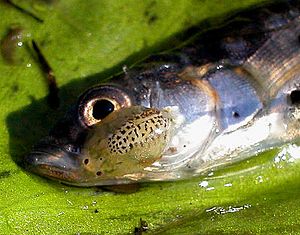Fish lice facts for kids
Quick facts for kids Fish lice |
|
|---|---|
 |
|
| Argulus sp. on a stickleback | |
| Scientific classification | |
| Kingdom: | |
| Phylum: | |
| Subphylum: | |
| Class: | |
| Subclass: |
Branchiura
|
| Order: |
Arguloida
Yamaguti, 1963
|
| Family: |
Argulidae
Leach, 1819
|
Fish lice are tiny creatures that belong to the animal family called Argulidae. They are also sometimes known as 'carp lice'. These interesting animals are a type of crustacean, which means they are related to crabs, lobsters, and shrimp.
Fish lice are parasitic. This means they live on or in another animal, called a host, and get their food from it. They often cause harm to their host. Fish lice belong to the class Maxillopoda.
Scientists believe that fish lice are very old types of creatures. However, we have not found any fossils of them. The Argulidae family is the only family in the larger group called the order Arguloida.
Contents
What are Fish Lice?
Fish lice are small, flat creatures. They are usually only a few millimeters long. They have a special mouth part that helps them feed on the blood and body fluids of fish. They also have strong suckers to hold onto their host.
How Fish Lice Live
Fish lice attach themselves to the outside of fish. They can be found on the skin, fins, or gills. They use their sharp mouthparts to pierce the fish's skin. Then they feed on its blood and mucus. This can make the fish sick.
Impact on Fish
When many fish lice are on a fish, it can cause problems. The fish might become weak or stressed. It can also get infections where the lice have bitten it. This is especially true for fish in ponds or fish farms.
Where are Fish Lice Found?
Fish lice live all over the world. They are found in both fresh water and salt water. They can infect many different types of fish. This includes common fish like carp, goldfish, and trout.
How to Control Fish Lice
In places like fish farms, people try to control fish lice. They use special treatments to remove the parasites. This helps keep the fish healthy. It also prevents the spread of lice to other fish.
See also
 In Spanish: Argulidae para niños
In Spanish: Argulidae para niños

